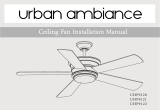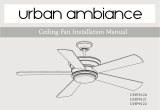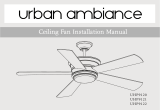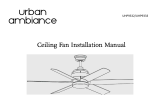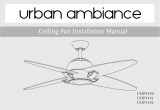Page is loading ...

UHP9220
UHP9221
UHP9222

Safety Rules
Unpacking Your Fan
Installing Your Fan
Making the Electrical Connections
Operating Your Fan
Care of Your Fan
Troubleshooting
Specications
Table of Contents
1
2
3
6
9
10
10
11

1. To reduce the risk of electric shock, insure electricity has been
turned off at the circuit breaker or fuse box before beginning.
2. All wiring must be in accordance with the National Electrical
Code ANSI/NFPA 70-1999 and local electrical codes. Electrical
installation should be performed by a qualied licensed electrician.
3. CAUTION: To reduce the risk of personal injury, use only the
screws provided with the electrical box.
4. The outlet box and support structure must be securely mounted and
capable of reliably supporting 35 lbs. (15.9 kg). Use only cUL Listed
outlet boxes marked “Acceptable for Fan Support of 35 lbs. (15.9
kg) or less.”
5. CAUTION: The fan must be mounted with a minimum of 7 feet
clearance from the trailing edge of the blades to the oor.
6. Do not operate reversing switch while fan blades are in motion.
Fan must be turned off and blades stopped before reversing blade
direction.
7. Avoid placing objects in path of the blades.
8. To avoid personal injury or damage to the fan and other items, be
cautious when working around or cleaning the fan.
9. Do not use water or detergents when cleaning the fan or fan blades.
A dry dust cloth or lightly dampened cloth will be suitable for most
cleaning.
10. After making electrical connections, spliced conductors should
be turned upward and pushed carefully up into electrical box. The
wires should be spread apart with the grounded conductor and the
equipment-grounding conductor on one side of the electrical box
and ungrounded conductor on the other side of the electrical box.
11. Electrical diagrams are for reference only. Light kits that are not
packed with the fan must be cUL Listed and marked suitable for use
with the model fan you are installing. Switches must be cUL General
Use Switches. Refer to the instructions packaged with the light kits
and switches for proper assembly.
12. All set screws must be checked and retightened where necessary
before installation.
13. WARNING: To reduce the risk of re or electric shock, this fan
should only be used with fan speed control part no. UC9031
(P2630), manufactured by Rhine Electronic Co., Ltd.
14. Suitable for use with solid-state speed controls.
1. Safety Rules
READ AND SAVE THESE INSTRUCTIONS
TO REDUCE THE RISK OF FIRE, ELECTRIC SHOCK OR PERSONAL
INJURY, MOUNT TO OUTLET BOX MARKED “ACCEPTABLE FOR
FAN SUPPORT OF 35 LBS. (15.9 KG) OR LESS”, AND USE SCREWS
PROVIDED WITH THE OUTLET BOX.
TO REDUCE THE RISK OF PERSONAL INJURY, DO NOT BEND THE
BLADE BRACKETS (ALSO REFERRED TO AS (“FLANGES”) DURING
ASSEMBLY OR AFTER INSTALLATION. DO NOT INSERT OBJECTS IN
THE PATH OF THE BLADES.
TO REDUCE THE RISK OF SHOCK, THIS FAN MUST BE INSTALLED
WITH AN ISOLATION CONTROL/SWITCH.

3
2
15
4
6
7
8
10
9
a. Blade attachment hardware
(10 Screws)
b. Electrical hardware & Balancing kit
(3 plastic wire connectors, blade
balancing kit)
5. Fan Motor Assembly
6. Blades (3)
7. Light Kit Pan
8. Light Kit Fitter Assembly
9. Glass Shade
10. Wall Control
1. Mounting Bracket (inside canopy)
2. 4.5” Ball/Downrod Assembly (hanger pin
and locking pin pre-attached)
3. Canopy with Canopy Ring (attached)
4. Decorative Motor Collar Cover
2. Unpacking Your Fan
Unpack your fan and check the contents. You should have the following items:
ab

3. Installing Your Fan
Tools Required
Phillips screw driver or straight slotted screw
driver, adjustable wrench, step ladder, and
wire cutters.
Mounting Options
If there isn’t an existing electrical box, then
read the following instructions. Disconnect
the power by removing fuses or turning off
circuit breakers.
Secure the electrical box directly to the building
structure. Use appropriate fasteners and
building materials. The electrical box and
its support must be able to fully support the
moving weight of the fan (at least 35 lbs.).
Do not use plastic electrical boxes.
Figures 1, 2, and 3 are examples of different
ways to mount the electrical box.
Note: You may need a longer downrod to
maintain proper blade clearance when installing
on a steep, sloped ceiling. The maximum
allowable angle is 30˚.
To hang your fan where there is an existing
xture but no ceiling joist, you may need an
installation hanger bar as shown in Figure 4.
TO REDUCE THE RISK OF FIRE, ELECTRIC
SHOCK OR PERSONAL INJURY, MOUNT
TO OUTLET BOX MARKED “ACCEPTABLE
FOR FAN SUPPORT OF 35LBS. (15.9 KG) OR
LESS”, AND USE SCREWS PROVIDED WITH
THE OUTLET BOX. ELECTRICAL BOXES
COMMONLY USED FOR THE SUPPORT
OF LIGHTING FIXTURES MAY NOT BE
ACCEPTABLE FOR FAN SUPPORT AND
MAY NEED TO BE REPLACED. CONSULT A
QUALIFIED ELECTRICIAN IF IN DOUBT.
Figure 1
Figure 2
Figure 4
Figure 3

4.
Hanging the Fan
REMEMBER to turn off the power. Follow
the steps below to hang your fan properly.
NOTE: This fan is recommended for
standard ceiling mount using the downrod
provided with this fan. When using standard
ceiling installation with the 4.5 inch downrod
provided, the distance from the ceiling
to the bottom of the fan blades will be
approximately 12.9 inches.
Standard Ceiling Mounting
1. Remove the canopy ring from the canopy
by turning the ring to the right until it
unlocks. (Figure 5)
2. Remove the mounting plate from the
canopy by loosening the four screws on
the top of the canopy. Remove the two
non-slotted screws and loosen the slotted
screws. This will enable you to remove
the mounting plate. (Figure 6)
3. Remove the hanger pin and locking pin
from downrod assembly.
4. Route the wires exiting the top of the fan
motor through the decorative motor collar
cover then the canopy ring. Make sure the
slot openings are on top. Route the wires
through the canopy and then through the
ball/downrod assembly. (Figure 7)
Remove
Loosen but Do Not Remove
Turn Canopy Ring to Remove
Figure 5
Figure 6
5. Loosen, but do not remove, the set screws
on the collar on the top of the motor
housing.
6. Align the holes at the bottom of the
downrod with the holes in the collar on top
of the motor housing. (Figure 7)
Carefully insert the hanger pin through the
holes in the collar and downrod. Be careful
not to jam the hanger pin against the wiring
inside the downrod. Insert the locking pin
through the hole near the end of the hanger
pin until it snaps into its locked position, as
noted in the circle inset of Figure 7.
7. Re-tighten the set screws on the motor collar
on top of the motor housing.
8. Make sure the grommet is properly installed
in the collar cover, then slide the collar cover
on the downrod until it rests on the motor
housing. Be sure that the canopy and the
collar cover are both oriented correctly.
9. Proceed to “Installing the Fan” section.
FAILURE TO PROPERLY INSTALL SET SCREWS
AS NOTED IN STEP 7 COULD RESULT IN FAN
LOOSENING AND POSSIBLY FALLING.
Figure 7
Reversing
Switch
Pin in
Position
Locked
Motor Wires
Ball/Downrod
Assembly
Canopy
Canopy
Ring
Collar
Cover
Motor
Tighten
Screws
Motor
Collar
Hanger
Pin Locking
Pin

Standard mounting
5.
Installing Fan to
the Electrical Box
WHEN MOUNTING THE FAN ON A SLOPED
CEILING, THE STANDARD BALL/DOWNROD
MOUNTING METHOD MUST BE USED. THE
MOUNTING PLATE MUST BE MOUNTED SO
THAT THE SLOT OPENINGS ARE ON THE
LOWER SIDE BY SLIDING THE MOUNTING
PLATE FROM THE TOP DOWN.
1. Pass the 120-volt supply wires through the
center hole in the ceiling mounting plate as
shown in Figure 8.
2. Install the ceiling mounting bracket on the
electrical box by using the mounting screws
provided with the electrical box. Note that
the at side of the mounting plate is toward
the electrical box. (Figure 8)
3. Tighten the two screws on the electrical box
securely.
4. Carefully lift the fan assembly up to the
ceiling mounting plate. Make sure the tab
on the mounting plate is properly seated in
the groove in the hanger ball. (Figure 9)
Figure 8
Washers
120V
Wires
UL Listed
Electrical
Box
Ceiling
Mounting
Bracket
Hook
Mounting
Screws
(Supplied with
Electrical Box)
WHEN USING THE STANDARD BALL/DOWNROD
MOUNTING, THE TAB IN THE RING AT THE
BOTTOM OF THE MOUNTING BRACKET MUST
REST IN THE GROOVE OF THE HANGER BALL.
FAILURE TO PROPERLY SEAT THE TAB IN THE
GROOVE COULD CAUSE DAMAGE TO WIRING.
Figure 9

6.
EACH WIRE NUT (WIRE CONNECTOR) SUPPLIED
WITH THIS FAN IS DESIGNED TO ACCEPT UP TO
ONE 12 GAUGE HOUSE WIRE AND TWO WIRES
FROM THIS FAN. IF YOU HAVE LARGER THAN
12 GAUGE HOUSE WIRING OR MORE THAN
ONE HOUSE WIRE TO CONNECT TO THE FAN
WIRING, CONSULT AN ELECTRICIAN FOR THE
PROPER SIZE WIRE NUTS TO USE.
INSTALLATION OF THIS WALL CONTROL
REQUIRES THAT THE THREE-CONDUCTOR
CABLE WITH GROUND WIRE BE RUN BETWEEN
THE CONTROL WALL BOX AND THE CEILING
FAN OUTLET.
Figure 10
Making the Electrical
Connections
REMEMBER to disconnect the power. If you
feel you do not have enough electrical
wiring knowledge or experience, have your fan
installed by a licensed electrician.
Follow the steps below to connect the fan to
your household wiring. Use the wire
connectors supplied with your fan. Secure the
connectors with electrical tape. Make sure
there are no loose strands or connections.
(Figure 10)
1. After electricity has been turned off at the
main fuse box or circuit breaker panel,
remove the existing wall plate and switch.
2. Proceed to connect the wires as follows
(make sure the fan and light slide switches
of the wall control are set in “OFF”
position); Connect the solid black wire
from the wall control to the black wire
from the fan. Connect the red or blue wire
from the wall control to the black wire
from the fan. Connect the black with white
stripes wire from the wall control to the
120V AC hot wire. Use wire connectors
provided to secure the connections.
If your outlet box has a ground wire (green
or bare copper), connect the wall transmitter’s
ground wire to it; otherwise connect the wall
transmitter’s ground wire directly to one of the
screws from the outlet box.
NOTE: Refer to the Schematic on the back
of the wall control.
3. Secure the UC9031 (P2630) wall control to
the outlet box using the two 6-32” x 3/4”
screws provided.
4. Secure the face plate over the wall control
with the two 6-32” x 1/4” screws provided.
BLACK / WHITE
RED or BLUE
BLACK
BLACK
RED or BLUE
BLACK / WHITE
RED or BLUE
BLACK
BLUE
BLACK
GREEN
TO
GROUND
WHITE
WHITE
INPUT
BLACK
AC 120V
FAN
(2) #6 - 32 x 1/4” SCREWS
(2) #6 - 32 x 3/4” SCREWS
BLACK / WHITE

Attaching the Fan
Blades
1. Insert the blade through the slot cut-off in
the center ywheel, align the three screw
holes in the blade with the screw holes in
the ywheel and secure with the screws
provided. (Figure 11)
2. Repeat for the remaining blades.
Figure 11
Figure 12
Blade Balancing
All blades are grouped by weight. Because
natural woods vary in density, the fan may
wobble even though the blades are weight
matched.
The following procedure should correct most
fan wobble. Check after each step.
1. Check that all blade screws are secure.
2. Most fan wobble problems are caused
when blade levels are unequal. Check this
level by selecting a point on the ceiling
above the tip of one of the blades. Measure
from a point on the center of each blade
to the point on the ceiling. Measure this
distance as shown in Figure 12. Rotate
the fan until the next blade is positioned
for measurement. Repeat for each blade.
Measurements deviation should be within
1/8”. Run the fan for 10 minutes.
Finishing the Fan
Installation
STANDARD CEILING MOUNTING
1. Align the locking slots of the ceiling
canopy with the two screws in the mounting
plate. Push up to engage the slots and turn
clockwise to lock in place. Immediately
tighten the two mounting screws rmly.
2. Install the remaining two mounting
screws into the holes in the canopy and
tighten rmly.
3. Install the decorative canopy ring by
aligning the ring’s slots with the screws
in the canopy. Rotate the ring counter-
clockwise to lock in place.
4. You may now proceed to attaching the
fan blades.
WHEN USING THE STANDARD BALL/DOWNROD
MOUNTING, THE TAB IN THE RING AT THE
BOTTOM OF THE MOUNTING PLATE MUST
REST IN THE GROOVE OF THE HANGER BALL.
FAILURE TO PROPERLY SEAT THE TAB IN THE
GROOVE COULD CAUSE DAMAGE TO WIRING.
3. Make sure that canopy is tightened securely
to ceiling mounting bracket and that the
ceiling mounting bracket is tightened
securely to the electrical box.
4. Interchanging two adjacent blades can
redistribute the weight and possibly result
in the smoother operation.
5. Use the enclosed Blade Balancing Kit if the
blade wobble is still noticeable.
7.

8.
Installing the Light Kit
and Glass Shade
CAUTION - To reduce the risk of electrical
shock, disconnect the electrical supply circuit
to the fan before installing the light kit.
Blue White
Molded
Adaptor Plugs
Black White
Mounting
Screw (3)
Light Kit
Assembly
LED
Module
GlassLight Kit
Assembly
Raised
Dimples
Flat Area
Figure 14
Figure 15
Mounting
Screw (3)
Light Kit
Assembly
Light Kit
Adapter
Figure 13
PERIODICALLY CHECK THE SHADE IS SEATED
FULLY CLOCKWISE IN THE LIGHT KIT PAN
ASSEMBLY
1. Loosen but do not remove two of three
mounting screws from the fan motor
assembly; Remove one mounting screw.
(Figure 13)
2. Push the light kit pan up to the fan motor
assembly so that the two loosened screw
heads t into the keyhole slots. Turn the
light kit pan clockwise, tighten the screws.
Re-install the screw that was removed in
step 1 and tighten rmly.(Figure 13)
3. Remove one screw from the light kit pan
and loosen, but do not remove, the other
two screws. Connect the wires from the
light kit assembly to the wires from the fan
motor assembly by connecting the molded
adaptor plugs together. Carefully tuck
all wires and splices into the switch cap.
(Figure 14)
4. Push the light kit assembly up so that
the two loosened screw heads t into the
keyhole slots. Turn the light kit assembly
clockwise, tighten the screws. Reinstall
the screw that was removed in step 3 and
tighten rmly. (Figure 15)
5. Place the glass shade into the light kit
pan, aligning the three at areas on the
top of the glass shade with the three raised
dimples in the light kit pan. Turn the glass
shade clockwise until it stops. (Figure 15)
THE GLASS IS FRAGILE, USE CARE WHEN
INSTALLING THE LIGHT KIT AND THE GLASS
SHADE.

9. Operating Your Fan
Speed settings for warm or cool weather depend
on factors such as room size, ceiling height,
number of fans, and so on.
The fan shipped from the factory with the
reversing switch positioned to circulate air
downward. If airow is desired in the opposite
direction, turn your fan off and wait for the
blades to stop turning, then slide the reversing
switch (located at the top of the motor housing,
refer to gure 7 on page 4) to opposite position,
and turn fan on again. The fan blades will turn
in the opposite direction and reverse airow. Figure 16
Figure 17
Warm weather - (Forward) A downward air
ow creates a cooling effect as shown in Figure
16. This allows you to set your air conditioner
on a higher setting without affecting your
comfort.
Cool weather - (Reverse) An upward air ow
moves warm air off the ceiling are as shown in
Figure 17. This allows you to set your heating
unit on a lower setting without affecting your
comfort.

10. Care of Your Fan and Troubleshooting
Care of Your Fan
Here are some suggestions to help you
maintain your fan.
1. Because of the fan’s natural movement,
some connections may become loose.
Check the support connections, brackets,
and blade attachments twice a year. Make
sure they are secure. (It is not necessary to
remove fan from ceiling.)
2. Clean your fan periodically to help maintain
its new appearance over the years. Do not
use water when cleaning, this could damage
the motor, or the wood or possibly cause
an electrical shock. Use only a soft brush
or lint-free cloth to avoid scratching the
nish. The plating is sealed with a lacquer
to minimize discoloration or tarnishing.
Warning - Make sure the power is off
before cleaning your fan.
3. You can apply a light coat of furniture polish
to the wood for additional protection and
enhanced beauty. Cover small scratches
with a light application of shoe polish.
4. There is no need to oil your fan.
The motor has permanently lubricated
sealed ball bearings. MAKE SURE THE POWER IS OFF AT THE ELECTRICAL PANEL BOX
BEFORE YOU ATTEMPT TO MAKE ANY REPAIRS. REFER TO THE SECTION,
“MAKING ELECTRICAL CONNECTIONS.”
Fan will not start
Fan sounds noisy
1. Check main and branch circuit fuses or breakers
2. Check line wire connections to the fan and switch wire connections in
the switch housing. CAUTION: Make sure main power is off.
1. Make sure all motor housing screws are snug.
2. Make sure the screws that attach the fan blade bracket to the motor hub
are tight.
3. Make sure wire nut connections are not rattling against each other or
the interior wall of the switch housing.
CAUTION: Make sure power is off.
4. Allow a 24-hour “breaking in” period. Most noises associated with a
new fan disappear during this time.
5. Make sure the canopy is a short distance from the ceiling.
It should not touch the ceiling.
6. Make sure your electrical box is secure and rubber isolator pads were
used between the mounting bracket and electrical box.
Troubleshooting
Problem Solution

11. Specications
FAN
SIZE SPEED VOLTS
FAN POWER
CONSUMPTION
(WITHOUT LIGHTS)
WATTS
AIRFLOW
CFM
AIRFLOW
EFFICIENCY
(HIGHER IS BETTER)
CFM/WATT
NET
WEIGHT
GROSS
WEIGHT
CUBE
FEET
52”
Low
120
9 1999 222 14.77
Lbs
16.54
Lbs 1.43
High 42 4306 103
/


